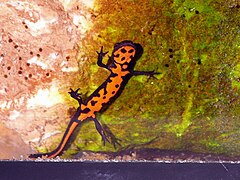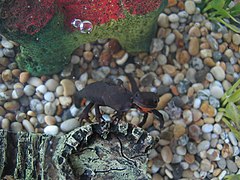Chinese fire belly newt
| Chinese fire belly newt | |
|---|---|

| |
| Scientific classification | |
| Domain: | Eukaryota |
| Kingdom: | Animalia |
| Phylum: | Chordata |
| Class: | Amphibia |
| Order: | Urodela |
| Family: | Salamandridae |
| Genus: | Cynops |
| Species: | C. orientalis
|
| Binomial name | |
| Cynops orientalis (David, 1873)
| |
| Synonyms | |
|
Hypselotriton orientalis (David, 1873) | |
The Chinese fire belly newt (Cynops orientalis) is a small (2.2–4.0 inches (5.6–10.2 cm)) black newt, with bright-orange aposematic coloration on their ventral sides. C. orientalis is commonly seen in pet stores, where it is frequently confused with the Japanese fire belly newt (C. pyrrhogaster) due to similarities in size and coloration. C. orientalis typically exhibits smoother skin and a rounder tail than C. pyrrhogaster, and has less obvious parotoid glands.[2]
C. orientalis is endemic to subtropical forests in East-Central China and prefers to live in shallow, semiaquatic environments such as abandoned paddies and ponds with dense vegetation.[3] Like many amphibians, the Chinese fire belly newt hibernates. In order to maintain homeostasis, clusters of melanin cells will gather in the liver, darkening the skin of the newt.[4]
gsdf, or Gonadal Soma-Derived Factor, is a gene functioning in testis development within fish, and had previously only been seen in fish until a transcriptome of the Chinese fire belly newt revealed that it is also present in some tetrapods.[5]
Breeding Ecology[edit]
Chinese fire belly newts typically spawn in ponds, ditches, wells, and fields, ideally with a water temperature within 15-23°C. Eggs are often deposited on aquatic plants and have a typical incubation time of 13-24 days. Breeding takes place from March to July, with the most spawning occurring in April and May. After the female takes the spermatophore from the male, spawning generally occurs within 65 days. Populations have been found to have a male-biased skewed sex ratio.[3] Sexual maturity of the species is reached within 1 to 3 years.[5]
Toxicology[edit]
Chinese fire belly newts are mildly poisonous and excrete toxins through their skin. Consisting primarily of tetrodotoxins, newts of the genus Cynops pose a medically significant threat if enough toxins are consumed, and toxins may cause numbness or irritation on skin contact.[6]
Gallery[edit]
-
Underside
-
Underwater
-
A pair
-
Biofluorescence
See also[edit]
References[edit]
- ^ IUCN SSC Amphibian Specialist Group (2020). "Cynops orientalis". IUCN Red List of Threatened Species. 2020: e.T59442A63868627. doi:10.2305/IUCN.UK.2020-1.RLTS.T59442A63868627.en. Retrieved 20 November 2021.
- ^ "Caudata Culture Species Entry – Cynops orientalis – Chinese firebelly". Caudata.org.
- ^ a b Yu, Tong Lei; Chen, Jian Bin (30 January 2015). "Microhabitat selection of the Chinese Fire-bellied Newt, Cynops orientalis (David, 1873), in the lowlands of the central plains of China" (PDF). Herpetozoa. 27: 159–162 – via ZOBODAT.
- ^ Xie, Zhaohui (2012). "Histological Study of the Liver Pigmentation of Chinese Fire-bellied Newt (Cynops orientalis) During Activity and Hibernation Periods". Asian Herpetological Research. 3 (4): 322–326. doi:10.3724/SP.J.1245.2011.00322.
- ^ a b Biscotti, Maria Assunta; Carducci, Federica; Barucca, Marco; Gerdol, Marco; Pallavicini, Alberto; Schartl, Manfred; Canapa, Adriana; Adolfi, Mateus Contar (25 March 2020). "The transcriptome of the newt Cynops orientalis provides new insights into evolution and function of sexual gene networks in sarcopterygians". Scientific Reports. 10 (1): 5445. doi:10.1038/s41598-020-62408-x. ISSN 2045-2322.
- ^ Brodie Jr., Edmund D.; Hensel Jr., John; Johnson, Judith (1974). "Toxicity of the Urodele Amphibians Taricha, Notophthalmus, Cynops and Paramesotriton (Salamandridae)". Copeia. 2 (2): 506–511. doi:10.2307/1442542. JSTOR 1442542.
Further reading[edit]
- Chang, Mangven L. Y. 1936. Contribution à l'étude Morphologique, Biologique et systématique des Amphibiens urodèles de la Chine. Libraire Picart, Paris, 156 p.





